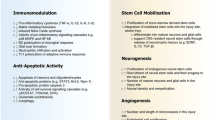Abstract
Objective
To confirm the feasibility and safety of granulocyte colony-stimulating factor (G-CSF) for treating spinal neuropathic pain associated with compression myelopathy, we have initiated an open-label single-center prospective clinical trial.
Methods
Between January 2009 and February 2011, 17 patients were accrued and were divided into two groups. One group included 7 patients who complained of pain associated with worsening symptoms of myelopathy (progressing myelopathy-related pain group). The other group included 10 patients who complained of pain that persisted after surgery for compression myelopathy (post-operative persistent pain group). All patients underwent intravenous administration of G-CSF (10 μg/kg/day) for 5 consecutive days. Pain severity was evaluated using a visual analog scale (VAS) before and after G-CSF administration.
Results
In 14 of the 17 patients, pain was relieved within several days after G-CSF administration. Pain disappeared completely in 3 patients. In the progressing myelopathy-related pain group, the mean VAS score was 71.4/100 before G-CSF administration, and decreased to 35.9/100 at 1 week after G-CSF administration (p < 0.05). In the post-operative persistent pain group, the mean VAS score was 72.0/100 before G-CSF administration, and decreased to 51.7/100 at 1 week after G-CSF administration (p < 0.05). No severe adverse events occurred during or after G-CSF administration.
Conclusions
The present results provide us with the possibility that G-CSF has a pain-relieving effect for neuropathic pain in patients with compression myelopathy.




Similar content being viewed by others
References
Baastrup C, Finnerup NB (2008) Pharmacological management of neuropathic pain following spinal cord injury. CNS Drugs 22:455–475
Cardenas DD, Warms CA, Turner JA et al (2002) Efficacy of amitriptyline for relief of pain in spinal cord injury: results of a randomized controlled trial. Pain 96:365–373
Gibson CL, Jones NC, Prior MJ et al (2005) G-CSF suppresses edema formation and reduces interleukin-1β expression after cerebral ischemia in mice. J Cereb Blood Flow Metab 25:431–439
Kawabe J, Koda M, Hashimoto M et al (2011) Granulocyte colony-stimulating factor (G-CSF) exerts neuroprotective effects via promoting angiogenesis after spinal cord injury in rats. J Neurosurg Spine 15:414–421
Kawada H, Takizawa S, Takanashi T et al (2006) Administration of hematopoietic cytokines in the subacute phase after cerebral infarction is effective for functional recovery facilitating proliferation of intrinsic neural stem/progenitor cells and transition of bone marrow-derived neuronal cells. Circulation 113:701–710
Koda M, Nishio Y, Kamada T et al (2007) Granulocyte colony-stimulating factor (G-CSF) mobilizes bone marrow-derived cells into injured spinal cord and promotes functional recovery after compression-induced spinal cord injury in mice. Brain Res 1149:223–231
Komine-Kobayashi M, Zhang N et al (2006) Neuroprotective effect of recombinant human granulocyte colony-stimulating factor in transient focal ischemia of mice. J Cereb Blood Flow Metab 26:402–413
Levendoglu F, Ogün CO, Ozerbil O et al (2004) Gabapentin is a first line drug for the treatment of neuropathic pain in spinal cord injury. Spine 29:743–751
Masaki Y, Yamazaki M, Okawa A et al (2007) An analysis of factors causing poor surgical outcome in patients with cervical myelopathy due to ossification of the posterior longitudinal ligament: anterior decompression with spinal fusion versus laminoplasty. J Spinal Disord Tech 20:7–13
New PW, Lim TC, Hill ST et al (2007) A survey of pain during rehabilitation after acute spinal cord injury. Spinal Cord 35:658–663
Nicola NA, Metcalf D, Matsumoto M et al (1983) Purification of a factor inducing differentiation in murine myelomonocytic leukemia cells. Identification as granulocyte colony-stimulating factor. J Biol Chem 258:9017–9023
Nishio Y, Koda M, Kamada T et al (2007) Granulocyte colony-stimulating factor attenuates neuronal death and promotes functional recovery after spinal cord injury in mice. J Neuropathol Exp Neurol 66:724–731
Petersen GL, Finnerup NB, Nørskov KN et al (2012) Placebo manipulations reduce hyperalgesia in neuropathic pain. Pain 153:1292–1300
Rintala DH, Holmes SA, Courtade D et al (2007) Comparison of the effectiveness of amitriptyline and gabapentin on chronic neuropathic pain in persons with spinal cord injury. Arch Phys Med Rehabil 88:1547–1560
Ro LS, Chen SR, Chao PK et al (2009) The potential application of granulocyte colony stimulating factor therapy on neuropathic pain. Chang Gung Med J 32:235–246
Roberts AW (2005) G-CSF: a key regulator of neutrophil production, but that’s not all! Growth Factors 23:33–41
Sakuma T, Yamazaki M, Okawa A et al (2011) Neuroprotective therapy using granulocyte-colony stimulating factor for patients with worsening symptoms of compression myelopathy, part 1: a phase I and IIa clinical trial. Eur Spine J 21:482–489
Schäbitz WR, Kollmar R, Schwaninger M et al (2003) Neuroprotective effect of granulocyte colony-stimulating factor after focal cerebral ischemia. Stroke 34:745–751
Schneider A, Kuhn HG, Schäbitz WR (2005) A role for G-CSF (granulocyte-colony stimulating factor) in the central nervous system. Cell Cycle 4:1753–1757
Siddall PJ, Cousins MJ, Otte A et al (2006) Pregabalin in central neuropathic pain associated with spinal cord injury: a placebo-controlled trial. Neurology 67:1792–1800
Störmer S, Gerner HJ, Grüninger W et al (2007) Chronic pain/dysaesthesiae in spinal cord injury patients: results of a multicentre study. Spinal Cord 35:446–455
Yamazaki M, Sakuma T, Kato K et al (2012) Granulocyte colony-stimulating factor reduced neuropathic pain associated with thoracic compression myelopathy: report of 2 cases. J Spinal Cord Med (in press)
Acknowledgments
This work was supported by a Health Labour Science Research Grant of Japan.
Conflict of interest
No funds were received in support of this study.
Author information
Authors and Affiliations
Corresponding author
Rights and permissions
About this article
Cite this article
Kato, K., Yamazaki, M., Okawa, A. et al. Intravenous administration of granulocyte colony-stimulating factor for treating neuropathic pain associated with compression myelopathy: a phase I and IIa clinical trial. Eur Spine J 22, 197–204 (2013). https://doi.org/10.1007/s00586-012-2556-9
Received:
Revised:
Accepted:
Published:
Issue Date:
DOI: https://doi.org/10.1007/s00586-012-2556-9




